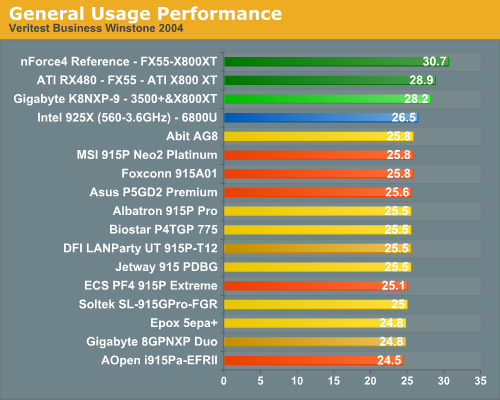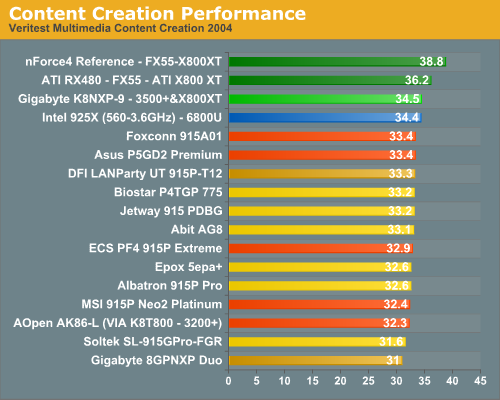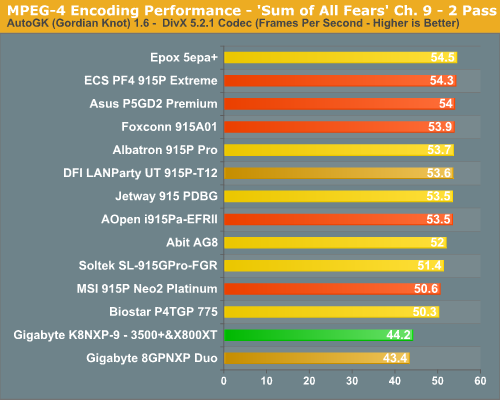915 Motherboard Roundup: Socket 775 for the Rest of Us
by Wesley Fink on December 7, 2004 12:25 AM EST- Posted in
- Motherboards
General Performance and Encoding




All tested motherboards were based on the same Intel 915 chipset and tested with the same CPU. The only difference was the memory supported by the board - either DDR or DDR2. So was DDR or DDR2 the winner? As we saw in our launch review for the 925X/915, the performance of fast DDR400 and DDR2-533 at aggressive timings is about the same. Having said that, some will still be surprised to see that there is really no winner in DDR or DDR2 in Winstones, even though we are comparing fast 2-2-2-5 DDR400 to fast DDR2-533 at 3-3-3-10. There is also no clear pattern of DDR2 or DDR performing better in these results. It appears that the performance is more dependent on the quality of the design than the type of memory used by the 915 board.
The same is true in results for PCMark 2004. There is a greater overall variation in PCmark scores, but no real pattern in terms of the type of memory used on the board. However, it is surprising to see such a wide range of results on PCMark 2004 tests on boards using the same chipset. The range of scores from 5000 to almost 5700 using the same CPU is extremely large. You will definitely see the performance difference in these boards. All the boards, but 4, are clustered between 5457 to 5690, but the bottom 4 boards are significantly slower with scores from 5007 to 5310.
2-pass Media Encoding results with AutoGk 1.6 and the DivX 5.2.1 Codec also reveal no clear performance pattern with either DDR or DDR2. You can choose either memory on a 915 board and be confident that performance will be competitive with other 915 boards and memory configurations.
One pattern that will emerge as we take a closer look at the benchmarks is that the same few motherboards are at the top of our test results over and over again. This will be even clearer in the DirectX 9 gaming tests. For those of you interested in comparisons to the Athlon 64, it is interesting that the FX55 totally dominates Winstones. On the other side, PCMark 2004 is dominated by the Intel boards. Clearly, both results cannot be correct, but are more a reflection of the design of each test and the features supported in each benchmark.










26 Comments
View All Comments
Live - Tuesday, December 7, 2004 - link
Sorry Didn't see your reply before I posted Wesley.Sure there is some value to be had but not "outstanding". I still don't agree with you but I guess my mind is made up. Intel needs to come out with something new before I go back.
As a roundup it was very good reading tough. I can't wait for the next AMD roundup to hit AnandTech.
Live - Tuesday, December 7, 2004 - link
#12"The P5GD2 is an expensive motherboard, at about $240 on the web, but you can get almost all the same features in the P5GD2 Deluxe for about $50 less."
Thats expensive to me. Compare that to the 134.99 for the 939 Gold Editors Choice winner "MSI K8N Neo2 Platinum"
But thats not the point. If the 915P was substantially cheaper then a 939 system you might call it value for money but is it not. Mind you a 939 board is generally not cheap either but at least it delivers in comparison.
The CPU used in the review that hardly beat the much cheaper 3500+ had a max overclock of 14% and I bet you would find it hard to reach that high without the CPU overheating and start throttling http://www.anandtech.com/news/shownews.aspx?i=2345...
LGA775 CPUs does not offer great overclocking headroom compared to the much cheaper earlier Intel platforms or AMD for that matter. Sure they still overclock but nothing that we haven't seen before at higher cost and temperature. Again not what I would call outstanding.
Wesley Fink - Tuesday, December 7, 2004 - link
#11 - We just ran the 3500+ benchmarks in the same configuration this morning, and we do agree that the 3500+ is a particularly good value in performance for the dollar. However, the larger picture of prices of AMD CPUs compared to Intel show the Intel processors are a good, if not outstanding, value.Our conclusion was based on Anand's value analysis in the 3.46EE/1066 launch review at http://www.anandtech.com/cpuchipsets/showdoc.aspx?... There he compared the 3800+ at over $600 to a Intel 560 3.6GHz at about $450 and found the 3800+ the winner but probably not a big enough winner to justify the price premium for the 3800+. At that time, there was no 570 (3.8GHz) and the 3.6 was the fastest Intel CPU unless you considered the $1000+ Xeon-based EE processors. Price changes continue, and with them the value relationships do change.
A quick check of prices today shows
Intel 520(2.8GHz)- $160 AMD 2800+(754) - $128
Intel 530(3.0GHz)- $180 AMD A64 3000+ - $152
Intel 540(3.2GHz)- $220 AMD A64 3200+ - $194
Intel 550(3.4GHz)- $282 AMD A64 3400+ - $269
Intel 560(3.6GHz)- $455 AMD A64 3500+ - $270
Intel 570(3.8GHz)- $795 AMD A64 3800+ - $630
AMD A64 4000+ - $716
AMD A64 FX55 - $812
With current prices we would have to agree that there is really no great value advantage to Intel any more. But there is good value in the Intel processors from 2.8GHz (520) to 3.6GHz (560). Certainly the 4000+, at $80 less than the 570 and faster performance, and the FX55 at about the same price as 570 and significantly faster in most benchmarks, are better value at the top. But we still stand by Intel being good value in the middle.
deathwalker - Tuesday, December 7, 2004 - link
"outstanding value and performance for your buying dollar" ?????????? at $240 for a Mobo?..I guess I need to retake Economics 101...Bah...Intel just continues to shot themselves in the foot. A side note not related to this review..Dell must be deep inside of Intel's pocketbook with there contiued refusal to market AMD based products.danidentity - Tuesday, December 7, 2004 - link
#11 - 915P motherboards are not expensive. They are equal or cheaper in price than socket 939 A64 motherboards.LGA775 CPUs offer great overclocking headroom if paired with the right board. Intel CPUs have traditionally have had more OCing headroom than AMD chips. That still holds true, for the most part, today. Especially when talking about the low-end chips, like the 2.8GHz.
Live - Tuesday, December 7, 2004 - link
I'm sorry but I don't see the "outstanding value and performance for your buying dollar"Expensive Motherboards and CPUs with little overclocking headroom compared to the Athlon 64 competition. How does that translate to excellent value and performance? even the much cheaper 3500 comes out on top on most benchmarks.
Sure there are niche markets where the Intel platform excels but for the big majority of us AMD is where its at right now.
I don't think this review is in sync with your conclusion so either list some valid arguments for your point (Since its not there in the benchmarks) or edit the conclusion.
danidentity - Tuesday, December 7, 2004 - link
Wesley, thanks for including tests from a more comparable AMD CPU. Listening to your readers is always appreciated.Wesley Fink - Tuesday, December 7, 2004 - link
#4,#5,#6 - The Athlon 64 results with the FX55 were included for Reference, and not direct comparison. However you do make a good point.The closest A64 we had in the lab to a 3.6GHz 560 was the 3500+ based on the 90nm process. This should provide an advantage to the Intel 560. Since there are complaints here the FX55 is too high end, these new tests tilted toward Intel should balance the playing field. The 3500+ costs about $265 and the Intel 560 (3.6GHz) is about $455, so the 560 is about 70% more expensive than the 3500+.
The added 3500+ benchmarks were also an opportunity to test with the SAME ATI X800XT PCIe we used in benchmarking the 915 boards. Enjoy!
Color codes have been updated and there are now 3500+ results on the Gigabyte nForce4 with the ATI X800XT PCIe in all benchmarks.
Original plans were to include the Intel 570 in this roundup, but much of the testing was already done when the Intel 3.8GHz CPU was launched. This Intel 3.8 is priced at around $800, which is very close to the FX55. You can see how it compares to the FX55 in performance in Anand's launch article at http://www.anandtech.com/cpuchipsets/showdoc.aspx?...
CrystalBay - Tuesday, December 7, 2004 - link
It's a pity that all these 4 dimm slot, dual channelMB's have such a rough time doing it. Imagine trying
to run 4 1GB dimms in DC, this goes for ddr1 as well 2.
Glassmaster - Tuesday, December 7, 2004 - link
Now that Northwood and 865/875 are on the way out, only a fool would buy Intel.Glassmaster.